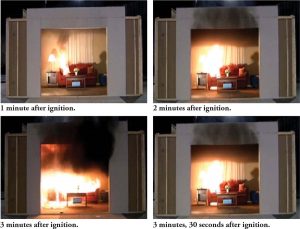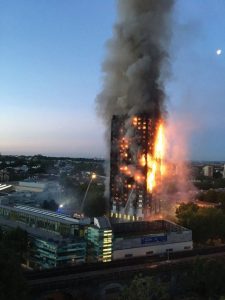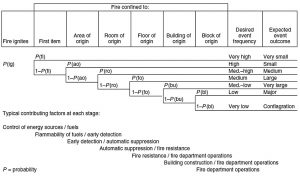Part 1
Structural engineers are not traditionally involved in the analysis or design of building fire safety. When they are, their focus is generally on structural fire protection and, with some exceptions, their scope is limited to ensuring compliance with prescriptive building code requirements for the fire resistance ratings of different building elements. But structural fire protection is just one aspect of a comprehensive framework for building fire safety. As demonstrated by the Grenfell Tower fire in London, shown in Figure 1, structural fire protection alone does not ensure the fire safety of a building or its occupants. While structural engineers may not practice in the field of fire protection engineering, it is useful for them to have at least a basic understanding of building fire safety issues.
This is the first of a 3-part series presenting an overview of fire protection for structural engineers. This article addresses the fire safety objectives that drive the design of fire protection systems and features in buildings. The second article will address the different fire safety features and systems that are deployed to meet these objectives. The third article will provide an overview of the emerging practice of structural fire engineering, which requires close collaboration between fire protection engineers and structural engineers.
Fire Safety
Before considering the different fire safety systems and features installed in buildings, it is useful to consider the fire safety objectives addressed by these systems, generally summarized as:
- Life safety – for both occupants and emergency responders
- Property protection
- Mission continuity
- Preservation of cultural heritage
- Protection of the environment (from fire effluent and fire protection agents)
Traditional prescriptive building regulations address these performance objectives implicitly by specifying the building fire safety systems and features required in different buildings. In performance-based fire safety design, performance objectives and criteria are explicitly stated, and engineering analyses are performed to demonstrate achievement of the stakeholder-agreed objectives and criteria. Performance-based design is most commonly used for complex buildings to demonstrate that the proposed design is at least “equivalent” to the prescriptive regulatory requirements for fire safety. This calls for an understanding of the implicit performance objectives associated with the regulatory requirements.
Life Safety
For life safety analysis, the fundamental fire safety objective is to ensure that building occupants are not injured by a fire. From a performance standpoint, this objective is typically addressed by either entirely evacuating a building or relocating occupants to safe areas within the building. Total evacuation is typically used for relatively small buildings, while partial or phased evacuation is more common for very large buildings, particularly high-rise structures. The fundamental objective associated with life safety from fire can be expressed as: Available safe egress time (ASET) > Required safe egress time (RSET).
The available safe egress time (ASET) depends on the rate of fire hazard development and the movement of smoke and heat throughout a building. In turn, the rate of fire hazard development depends on the flammability characteristics and configuration of fuels contributing to the fire, and on the presence or absence of automatic fire suppression systems to control or suppress fire development. The movements of smoke and heat from a fire depend on the compartmentation features of a building, including on individual floors, and for vertical pathways such as shafts, as well as on the response of mechanical ventilation (HVAC) systems under fire conditions. HVAC systems may be designed to simply shut down under fire conditions to prevent active circulation of smoke, or they may be designed to actively counter smoke flow, e.g., in pressurized exit stairs.
The required safe egress time (RSET) depends on many factors, including how quickly a fire is detected, how quickly occupants are notified, how effective the notification is (e.g., general evacuation alarm vs. voice communication system), how long occupants take to start the evacuation process, and, finally, how long it takes occupants to reach a place of safety once they start moving.
Property Protection
The objective of property protection is to limit the extent of physical damages to a level acceptable to the various stakeholders on a project. In general, the objective of property protection is of primary interest to property owners and their insurers; it is generally of less interest to building regulators, so it is not addressed explicitly in building regulations. However, property protection is addressed implicitly in building regulations in terms of height and area limits on buildings based on construction type, and in terms of requirements for automatic sprinkler protection.
The objective of property protection is commonly addressed through the application of automatic fire suppression systems. Automatic sprinkler systems are the predominant choice for property protection, but “clean agent” systems are frequently used in applications where water and smoke can damage sensitive equipment, such as electronics. Property protection is also addressed through compartmentation with fire barriers separating different fire areas to limit the maximum expected size of a fire and the maximum amount of property exposed to a fire.
Mission Continuity
The objective of mission continuity addresses potential disruptions to the mission of an enterprise or operation caused by fire. In the commercial insurance world, this type of loss is sometimes referred to as “business interruption.” The financial magnitude of such losses can far exceed the magnitude of direct property losses for some operations. However, these losses may be of primary concern to the mission operator and its insurance interests rather than to society in general.
Mission continuity can also be important at a community level. For example, a major fire that shuts down a hospital can have an impact on an entire region. A fire in a factory that employs a large percentage of the local population can also have a widespread impact on the local economy. In a performance-based design framework, such impacts may be addressed by the stakeholders, but in a prescriptive design framework, such impacts may not be addressed.
The mission continuity objective is typically addressed with the same fire protection systems and features used to meet the property protection objective. Both property protection and mission continuity objectives can be addressed by providing automatic fire suppression systems and by limiting the size of fire areas with fire barriers.
Preservation of Cultural Heritage
The objective of preserving cultural heritage artifacts and structures has limited application but is recognized as distinct for at least two reasons. First, the artifacts and structures being preserved are irreplaceable; if they are damaged by fire, smoke, or water, they may lose their intrinsic value. The second reason, which applies primarily to structures, is because the historical fabric can be compromised if modern fire protection features are introduced without due consideration of their impact. Nonetheless, this objective is typically addressed through the use of fire detection and fire suppression systems to detect and control a fire before it causes unacceptable damage.
Environmental Protection
Much like the previous objective, the environmental protection objective has had relatively limited application but is still worth mentioning. The primary ways to limit the potential environmental impacts of fire are to prevent fires and to control fires while they are still small. Where hazardous materials are involved, it may be necessary to use impoundment structures to limit runoff of hazardous materials and contaminated firefighting water. It is also necessary to consider environmental impacts of firefighting agents, such as firefighting foams and halogenated agents, before they are specified for an application.
Defense-in-Depth Approach to Fire Safety Design
The fire safety objectives discussed above differ from each other in terms of their goals, but the methods and means of achieving these objectives are often similar. The concept of defense-in-depth is fundamental to building fire safety design. As it applies to fire development, this concept can be summarized as:
- Prevent fires from igniting;
- Detect fires that do ignite while they are still small and manageable;
- Suppress fires while they are still small and manageable; and
- Confine fires that are not suppressed early with fire-resistive construction.
Different fire protection systems and features are designed to interact with and mitigate fires at different stages of their development. These systems and features are discussed in the second article in this series. Because the fire safety interventions occur sequentially, the probabilities and consequences associated with fire are sometimes represented using event trees, which show how the consequences change depending on the success or failure of each sequential mitigation strategy. An example fire event tree, with the associated fire safety features and systems that intervene at each stage, is shown in Figure 2.
One of the distinguishing aspects of fire safety design is that the “load” imposed by a fire changes dynamically as the fire grows, so the sooner successful intervention occurs, the smaller the impact will be. This is illustrated graphically in Figure 3, which shows the rapid development of a contemporary living room fire to “flashover” or “fully developed” conditions.

Figure 3. Living room fire transitioning through “flashover.” Courtesy of Kerber, S., “Impact of Ventilation on Fire Behavior in Legacy and Contemporary Residential Construction,” UL Firefighter Safety Research Institute, December 14, 2010.
Because of the threat flashover presents with respect to all the fire safety objectives discussed above, one common fire safety strategy is to prevent flashover, typically through the installation of automatic sprinkler systems. However, automatic sprinkler protection is not effective for all fire scenarios, so other mitigation measures still need to be considered. In particular, structural fire protection becomes important once a fire reaches flashover conditions, both in terms of confining the fire with fire barriers as well as maintaining the structural integrity of the building.
The defense-in-depth design approach used for fire is different from other building design disciplines, which frequently design for maximum or steady-state load conditions rather than transitory conditions.
Summary
The design of building fire safety typically uses a defense-in-depth approach to achieve fire safety objectives. In a prescriptive environment, the building code specifies the fire safety features and systems required to achieve the implicit fire safety objectives. In a performance-based environment, designers specify the fire safety features and systems needed to achieve stakeholder-agreed performance objectives. These fire safety features and systems will be discussed in the next article in this series.
The traditional role of the structural engineer in building fire safety design has been limited. However, this has been changing over the past two decades with the emergence of structural fire engineering as a distinct design discipline. This new role for structural engineers in the design of building fire safety will be discussed in more detail in the third article in this series.▪
References
Mowrer, F.W. and Rosenbaum, E.R., “Overview of Performance-Based Fire Protection Design,” Fire Protection Handbook, 20th edition, National Fire Protection Association, Quincy, MA, 2008.
Kerber, S., Impact of Ventilation on Fire Behavior in Legacy and Contemporary Residential Construction, UL Firefighter Safety Research Institute, December 14, 2010.


